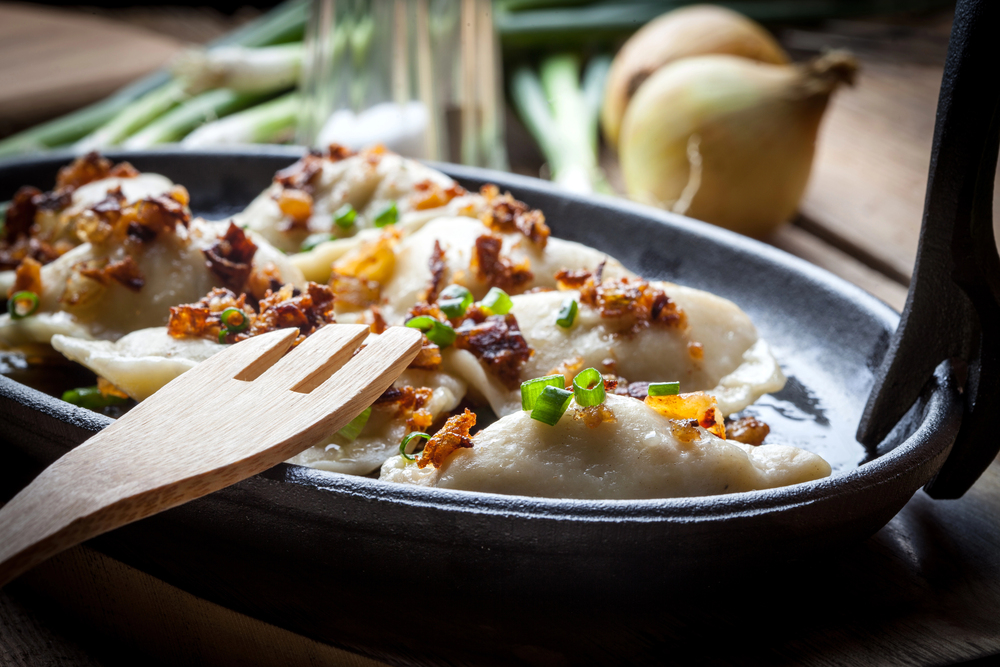Few dishes evoke the warmth and comfort of Polish cuisine quite like pierogi. These delightful dumplings, filled with a variety of savory or sweet ingredients, are a staple of Polish tables and a symbol of home cooking. Whether you grew up enjoying them at your Babcia’s house or are newly discovering their deliciousness, pierogi offer a taste of tradition and a truly satisfying culinary experience.
What are Pierogi?
Pierogi are traditional Eastern European dumplings that have captured the hearts and taste buds of many. Made with a pasta-like dough, these delightful pockets can be filled with a variety of ingredients, ranging from savory to sweet. Common fillings include potatoes, cheese, sautéed vegetables, and even fruit. Pierogi are a beloved dish in countries like Poland, Ukraine, and Russia, where they are enjoyed as a main course, side dish, or dessert.
The versatility of pierogi extends to their preparation methods. They can be boiled, fried, or baked, each method bringing out different textures and flavors. Once cooked, pierogi are often topped with delicious additions such as sour cream, melted butter, or crispy bacon bits, making them a truly customizable culinary delight.
A Brief History of the Pierogi
The origins of pierogi are shrouded in a bit of mystery, with some legends attributing their arrival in Poland to Saint Hyacinth in the 13th century. It’s said he brought the recipe from the Far East (possibly from Kyiv, which was part of Kyivan-Rus at that time), introducing these delectable dumplings to a grateful Polish population. Others say that pierogi are very similar to Asian dumplings, so they came from the East through ancient trade routes. Whatever their precise origins, pierogi have become deeply ingrained in Polish culture and are a beloved dish enjoyed across generations.
More Than Just a Dumpling: The Cultural Significance of Pierogi
Pierogi are more than just a food item; they’re a cultural symbol. They are often associated with family gatherings, holidays (especially Christmas Eve – Wigilia), and special occasions. Making pierogi together is often a cherished family activity, with recipes and techniques passed down through generations. Each family might have their own unique twist on the filling or dough, making their pierogi truly special.
The Anatomy of a Perfect Pierogi: Achieving Golden Brown Perfection
A classic pierogi consists of two main components: the dough and the filling.
- The Dough: Traditionally, pierogi dough is made from simple ingredients: flour, water, and sometimes egg and/or a touch of oil or sour cream. The dough should be soft, pliable, and easy to roll out thinly.
- The Filling: This is where the magic happens! Pierogi fillings are incredibly diverse, ranging from savory to sweet. Some of the most popular include:
- Potato and Cheese (Ruskie): A classic and arguably the most popular filling, combining mashed potatoes, cheese (often farmer’s cheese or twaróg), and sometimes fried onions.
- Sauerkraut and Mushroom: A flavorful and slightly tangy filling, perfect for those who enjoy a more robust taste.
- Meat: Ground meat (pork, beef, or a mixture) seasoned with onions and spices.
- Cabbage: Cooked cabbage, often seasoned with onions, mushrooms, and sometimes a hint of caraway seeds.
- Fruit Fillings: Sweet pierogi are popular, using fresh fruit like blueberries, strawberries, cherries or plums.
- Sweet Cheese: Using sweetened farmer’s cheese, this makes a popular dessert or breakfast pierogi.
Types of Pierogi Fillings
The beauty of pierogi lies in their endless filling possibilities, which can vary greatly depending on regional traditions and personal tastes. Here are some popular fillings that you might encounter:
- Potatoes and Cheese: This classic combination features creamy mashed potatoes blended with melted cheese, creating a comforting and satisfying filling.
- Sauerkraut and Mushrooms: For those who enjoy a tangy and savory flavor, this filling combines the tartness of sauerkraut with the earthiness of sautéed mushrooms.
- Meat: Ground meat, such as pork or beef, seasoned with onions and spices, makes for a hearty and flavorful filling.
- Fruits: Sweet pierogi are a treat, often filled with fresh strawberries, blueberries, or other fruits, perfect for dessert.
- Vegetables: Sautéed vegetables like spinach or carrots offer a lighter, yet equally delicious, option for pierogi fillings.
Cooking Pierogi: Beyond Boiling and Frying Pan Techniques
Traditionally, pierogi are boiled in boiling water until they float to the surface. This method ensures a soft, tender dumpling. Once boiled, many people choose to enhance them, browning them lightly in butter. This gives them a more crispy texture. To maintain the water at a gentle boil and avoid splashing hot water, stir occasionally and monitor the temperature closely.
To cook pierogies, you can also use methods like air frying or microwaving, which offer different textures and flavors.
However, boiling isn’t the only way to cook frozen perogies. Other methods include:
- Pan-Frying: After boiling, pierogi can be pan-fried in butter or oil until golden brown and crispy. This adds a delightful textural contrast.
- Baking: Pierogi can be baked in the oven, often brushed with butter or oil for a crispy exterior.
- Deep Frying: Creates the most crispy, but least healthy, outcome. Avoid fully submerging foods in oil. Maintain the oil temperature at 350°F and cook for 3-4 minutes until golden brown.
- Microwaving: A quick and easy method, perfect for when you’re short on time. See detailed instructions below.
Pan-Frying
Pan-frying is a popular method for cooking pierogi, adding a delightful crispy texture to the tender dumplings. Here’s how you can achieve that perfect golden brown finish:
- Heat the Pan: Start by heating a frying pan over medium heat. Add a small amount of cooking oil or olive oil to the pan.
- Add the Pierogi: Place the pierogi in the pan, ensuring they are not overcrowded.
- Cook: Fry the pierogi for about 3-4 minutes on each side, or until they turn golden brown and crispy.
- Serve: Once cooked, serve the pierogi with your favorite toppings, such as a dollop of sour cream or a sprinkle of crispy bacon bits.
Pan-frying pierogi not only enhances their flavor but also adds a satisfying crunch that contrasts beautifully with the soft filling.
Microwaving Frozen Pierogies: A Quick and Convenient Method
Yes, you can absolutely microwave pierogi! It’s a fantastic option for a quick lunch or a speedy weeknight dinner. Here’s a simple guide:
Microwaving Pierogies: General Guide
This method works well for most frozen pierogi brands, but it is advisable to check manufacturer directions on your package first.
- Prepare the Bowl: Select a microwave-safe bowl.
- Add Water: Place the frozen pierogi in the bowl and cover them completely with water. This is crucial for even cooking and preventing them from drying out.
- Cover Loosely: Cover the bowl loosely with microwave-safe plastic wrap. This helps trap steam and promotes even cooking. Vent by leaving a small opening to allow steam release.
- Microwave: Microwave on high power. Start with a shorter cooking time (e.g., 3-4 minutes) and then check for doneness. The exact time will depend on your microwave’s wattage and the number of pierogi.
- Check for Doneness: Pierogi are usually done when they float to the surface and are heated through. If they’re not quite done, continue microwaving in short intervals (30-60 seconds).
- Drain and Serve: Carefully drain the water (it will be hot!).
Microwaving Mrs. T’s Pierogies
Mrs. T’s, a popular brand of frozen pierogies, provides specific instructions for microwaving:
- Place frozen pierogies in a microwave-safe bowl.
- Cover the pierogies completely with water.
- Loosely cover the bowl with plastic wrap.
- Microwave on high for 7 minutes.
- Drain the water and serve.
Microwaving CHEEMO Perogies
CHEEMO Perogies suggests a slightly different approach:
- Place frozen pierogi in hot tap water for 3-4 minutes.
- Remove pierogi from the water, placing them in a microwave-safe dish.
- Cover with vented plastic wrap.
- Microwave on high power for 2-3 minutes.
- Remove and serve.
Important Considerations When Microwaving Pierogi
- Microwave Wattage: Microwaves vary in power. Adjust cooking times accordingly. Start with the lower end of the recommended time and add more as needed.
- Overcooking: Avoid overcooking, which can make the pierogi tough and rubbery.
- Dish: Always use a microwave-safe dish.
- Handling: Be careful when handling the bowl and pierogi after microwaving, as they will be very hot.
Serving Suggestions and Enhancements with Sour Cream
Once your pierogi are cooked (by whichever method you choose), the fun begins! Here are some classic serving suggestions:
- Melted Butter: A simple yet delicious topping.
- Sautéed Onions: Caramelized onions add a touch of sweetness and depth of flavor.
- Sour Cream: A dollop of sour cream provides a cool and tangy counterpoint to the savory fillings.
- Bacon Bits: Crispy bacon bits add a smoky and salty crunch.
- Fresh Herbs: Chopped dill, parsley, or chives provide a fresh, herbaceous element.
- Applesauce: Often served alongside sweet pierogi.
Pierogi Variations and Toppings
Pierogi are incredibly versatile and can be served in numerous ways to suit your taste. Here are some popular toppings and variations to consider:
- Sour Cream: A classic choice, sour cream adds a tangy and creamy flavor that complements savory pierogi perfectly.
- Melted Butter: Drizzling melted butter over pierogi adds a rich and savory touch.
- Bacon Bits: For a smoky and savory crunch, sprinkle some crispy bacon bits on top.
- Chopped Onions: Sautéed or caramelized onions bring a sweet and savory depth of flavor to your pierogi.
- Olive Oil: Use olive oil as a topping or for pan-frying to add a subtle, fruity flavor.
For those who love to experiment, pierogi can also be paired with various sauces, such as marinara or Alfredo, to create unique and delicious dishes. The possibilities are endless, so don’t hesitate to get creative and find your favorite way to enjoy these delightful dumplings.
Creative Pierogi Recipes Beyond the Basics
Pierogi are incredibly versatile. You can adapt them to suit your taste. Consider these ideas:
- Pierogi Stroganoff: Combine cooked pierogi with a creamy mushroom and sour cream sauce.
- Pierogi Nachos: Top cooked pierogi with your favorite nacho toppings (cheese, jalapenos, beans, etc.) and microwave until the cheese is melted.
- Pierogi Poutine: Create a Polish-Canadian fusion dish by topping crispy pierogi with cheese curds and gravy.
Where to Find Authentic Pierogi
While making pierogi from scratch is a rewarding experience, it can be time-consuming. Thankfully, you can easily find delicious, high-quality pierogi ready to cook. If you’re looking to enjoy this Polish delicacy without the fuss, you can conveniently buy pierogi online from Polka-Deli.com. We offer a wide selection of fillings, ensuring you’ll find your perfect pierogi.
Pierogi: A Taste of Poland, Ready to Enjoy
Pierogi are more than just food; they represent Polish culture, history, and heartwarming meals with family. Whether you choose to boil, fry, bake, or even microwave them, these versatile dumplings are guaranteed to satisfy. Embrace the tradition and savor the deliciousness of pierogi!










